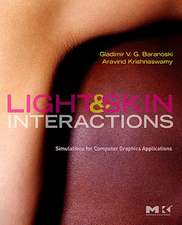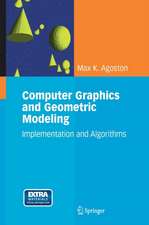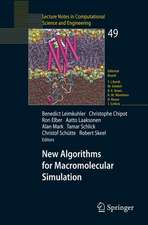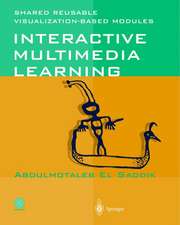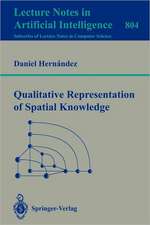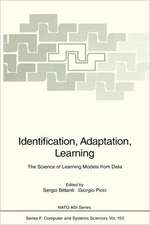Rotation Transforms for Computer Graphics
Autor John Vinceen Limba Engleză Paperback – 11 ian 2011
Rotation Transforms for Computer Graphics covers a wide range of mathematical techniques used for rotating points and frames of reference in the plane and 3D space. It includes many worked examples and over 100 illustrations that make it essential reading for students, academics, researchers and professional practitioners.
The book includes introductory chapters on complex numbers, matrices, quaternions and geometric algebra, and further chapters on how these techniques are employed in 2D and 3D computer graphics. In particular, matrix and bivector transforms are developed and evaluated to rotate points in a fixed frame of reference, and vice versa.
Preț: 387.01 lei
Preț vechi: 483.77 lei
-20% Nou
Puncte Express: 581
Preț estimativ în valută:
74.06€ • 77.67$ • 61.65£
74.06€ • 77.67$ • 61.65£
Carte tipărită la comandă
Livrare economică 01-15 aprilie
Preluare comenzi: 021 569.72.76
Specificații
ISBN-13: 9780857291530
ISBN-10: 085729153X
Pagini: 232
Ilustrații: XVI, 232 p. 106 illus.
Dimensiuni: 155 x 235 x 13 mm
Greutate: 0.35 kg
Ediția:2011
Editura: SPRINGER LONDON
Colecția Springer
Locul publicării:London, United Kingdom
ISBN-10: 085729153X
Pagini: 232
Ilustrații: XVI, 232 p. 106 illus.
Dimensiuni: 155 x 235 x 13 mm
Greutate: 0.35 kg
Ediția:2011
Editura: SPRINGER LONDON
Colecția Springer
Locul publicării:London, United Kingdom
Public țintă
GraduateCuprins
Introduction.- Complex Numbers.- Vectors.- Matrices.-Quaternions.- Multivectors.- Rotation Transforms in the Plane.-Frames of Reference in the Plane.- Rotation Transforms in Space.- Frames of Reference in Space.- Quaternion Transforms in Space.- Bivector Rotors.- Conclusion.- Appendix A: Composite Point Rotation Sequences.- Appendix B: Composite Frame Rotation Sequences.- Appendix C: The Four n-Square Algebras.- Index.
Recenzii
From the reviews:
“This book is devoted to rotation transforms applied in computer graphics. … The aim of the book is to take the reader through the important ideas and mathematical techniques associated with rotation transforms, without becoming too pedantic about mathematical terminology. … is presented in an accessible fashion, with many examples and figures explaining the theory in an intuitive way. It is suitable for students, academics, researchers and professional practitioners who are interested in making 2D or 3D scenes and animations.” (Agnieszka Lisowska, Zentralblatt MATH, Vol. 1221, 2011)
“The basic mathematics that underlies rotations in 2D or 3D graphics is straightforward. Making sure that the details are right can be maddening. The author of this book successfully brings order and method to the subject. … The book is a discussion of mathematical underpinnings. … This is a fine volume that should be of use to anyone who actually writes graphics (or robotics) libraries, and also to those who use animation packages and want to understand what is happening under the hood.” (Paul LaFollette, ACM Computing Reviews, September, 2011)
“This book is devoted to rotation transforms applied in computer graphics. … The aim of the book is to take the reader through the important ideas and mathematical techniques associated with rotation transforms, without becoming too pedantic about mathematical terminology. … is presented in an accessible fashion, with many examples and figures explaining the theory in an intuitive way. It is suitable for students, academics, researchers and professional practitioners who are interested in making 2D or 3D scenes and animations.” (Agnieszka Lisowska, Zentralblatt MATH, Vol. 1221, 2011)
“The basic mathematics that underlies rotations in 2D or 3D graphics is straightforward. Making sure that the details are right can be maddening. The author of this book successfully brings order and method to the subject. … The book is a discussion of mathematical underpinnings. … This is a fine volume that should be of use to anyone who actually writes graphics (or robotics) libraries, and also to those who use animation packages and want to understand what is happening under the hood.” (Paul LaFollette, ACM Computing Reviews, September, 2011)
Textul de pe ultima copertă
Rotation transforms are used everywhere in computer graphics from rotating pictures in editing software, to providing an arbitrary view of a 3D virtual environment. Although the former is a trivial operation, the latter can be a challenging task.
Rotation Transforms for Computer Graphics covers a wide range of mathematical techniques used for rotating points and frames of reference in the plane and 3D space. It includes many worked examples and over 100 illustrations that make it essential reading for students, academics, researchers and professional practitioners.
The book includes introductory chapters on complex numbers, matrices, quaternions and geometric algebra, and further chapters on how these techniques are employed in 2D and 3D computer graphics. In particular, matrix and bivector transforms are developed and evaluated to rotate points in a fixed frame of reference, and vice versa.
Rotation Transforms for Computer Graphics covers a wide range of mathematical techniques used for rotating points and frames of reference in the plane and 3D space. It includes many worked examples and over 100 illustrations that make it essential reading for students, academics, researchers and professional practitioners.
The book includes introductory chapters on complex numbers, matrices, quaternions and geometric algebra, and further chapters on how these techniques are employed in 2D and 3D computer graphics. In particular, matrix and bivector transforms are developed and evaluated to rotate points in a fixed frame of reference, and vice versa.
Caracteristici
Introduction to all the mathematical techniques employed in the book Clear and concise explanations of 2D and 3D rotation transforms Large number of illustrations to clarify rotational movements Includes supplementary material: sn.pub/extras

